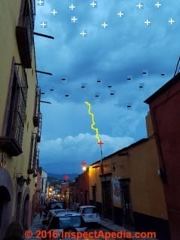 Lightning Bolt Formation & Types
Lightning Bolt Formation & Types
How does a lightning bolt form & move
- POST a QUESTION or COMMENT about how lightning protection systems actually work.
This article describes how a lightning strike forms and moves between the earth's surface (or a church steeple or tree) and a storm cloud
We describe the types and process of formation of groundstroke lightning. Lightning bolts also occur within storm clouds moving even horizontally as well as vertically.
This article series describes common lightning protection systems, certification, installation, and lightning protection system inspection. We provide information about lightning strikes, lightning hazards, related equipment, sources of lightning protection system installers, and lightning strike risk assessment
InspectAPedia tolerates no conflicts of interest. We have no relationship with advertisers, products, or services discussed at this website.
- Daniel Friedman, Publisher/Editor/Author - See WHO ARE WE?
Types & Forms of Lightning & Steps in Lightning Bolt Formation
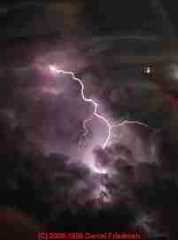 This article series, in two parts, describes first how a lightning strike forms and moves between a storm cloud and objects on the earth's surface, and second, how a lightning protection system installed on a church, tree, tower or other tall object reduces the chance of lightning damage by conducing the lightning strike more-safely to earth.
This article series, in two parts, describes first how a lightning strike forms and moves between a storm cloud and objects on the earth's surface, and second, how a lightning protection system installed on a church, tree, tower or other tall object reduces the chance of lightning damage by conducing the lightning strike more-safely to earth.
[Click to enlarge any image]
During a thunderstorm a cloud becomes statically charged with electricity. (The exact physics of how this static charge is formed are widely discussed but not perfectly understood.) The upper area of the storm cloud develops a positive charge, while the lower area of the cloud becomes negatively-charged.
Lightning bolts are static electricity discharges that can occur within a single cloud, between storm clouds, or of most-interest to earth-dwellers, as a lightning strike occurring between a storm cloud and the ground.
Our photograph shown here illustrates a lightning bolt moving between clouds or cloud areas well above ground. I photographed this lightning bolt from an aircraft flying over northern Minnesota.
[Click to enlarge any image]
History of Lightning Strike Research
Researching for this article series and zooming past Ben Franklin, kites and keys, we found a contemporary cloud of articles and opinions offering explanations of the phenomenon of lightning strikes including assertions that lightning bolts always move "up" from the ground, that lightning always moves "down" towards the ground from a cloud, horizontal lightning bolts, downward lightning leaders from a cloud that meet upward leaders from the ground, and return stroke lightning.
Here we'll sort out those terms, excerpting from or paraphrasing lightning experts. We focus exclusively on lightning strikes that make contact with the earth, and we ignore for now horizontal or other forms of lightning strikes that occur inside and stay within storm clouds.
Modern research on lightning and how its electrical current moves really began in the 1930's when storage oscilloscopes became available, making it possible for researchers like McEachron to actually measure lightning currents (at the Empire State Building in New York, in the U.S.) and for other experts to make lightning measurements in Switzerland, Italy, South Africa, and Russia. Heidler (2008) offers a lucid clarification of the types of lightning and the direction that lightning strike currents move.
The most-important, most-informative modern lightning research was performed by Berger who performed lightning current measurements in Switzerland between 1943-1971.
- Heidler (2008) in PARAMETERS of LIGHTNING CURRENT GIVEN in IEC 62305-background, experience and outlook." [PDF]
and cited in more detail atReferences or Citations , writing with Zischank, Flisowski, Bouquegneau, and Mazzetti have provided a lucid description of the types of lightning that actually occur. Portions of this page include my interpretation of that article - interpretation for which Heidler et als. bear no blame. Abstract extract:
The paper reviews the various types of lightning ground flashes, the current components relevant for protection and the current parameters obtained from measurements. |
On the basis of these measurements, some background information is given how TC 81 selected the parameters published in IEC 62305-1. F
inally, methods to simulate lightning currents in laboratory are presented which allow the verification of lightning protection measures or components.
Types of Lightning that Connect to Earth
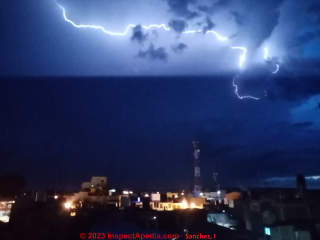 Photo: horizontal and vertical lighting bolts over central Mexico, photo courtesy of Isabel Sanchez.
Photo: horizontal and vertical lighting bolts over central Mexico, photo courtesy of Isabel Sanchez.
There are four key lightning strike terms, two describing the charge type and two describing the direction of movement of the initial lightning leader:
- Negative lightning:
a flash that transfers a negative charge from the cloud to the earth - Positive lightning:
a flash that transfers a positive electrical charge from the cloud to the earth - Downward lightning:
the initial lightning leader moves down from cloud to earth - most-common form affecting most structures - Upward lightning:
the initial lightning leader or in some current sources, the main component or charge of ground-stroke lightning, moves upward from earth to cloud - occurs particularly at very tall structures over 100m in height.
Downward Lightning - common
Downward lightning strikes are the most common forms that occur. The strike begins when an electrical charge leader forms in the storm cloud and moves downwards towards the ground.
 Negative downward lightning begins with a negative downwards leader. Positive downward lightning begins with a positive downwards leader.
Negative downward lightning begins with a negative downwards leader. Positive downward lightning begins with a positive downwards leader.
Of significance to most building owners and builders, those authors note that small buildings that are 100m or less in height are almost exclusively struck by downward lightning.
Downward Lightning Strikes - Negative Lightning
Our photo justa bove, edited to portray positive and negative areas of charge accumulating in a cloud over San Miguel de Allende in Guanajuato illustrates the formation of negative lightning in which an accumulation of negative charge in the bottom of the storm cloud forms a leader that moves downwards from the cloud bottom to earth.
A lightning strike to ground is basically a discharge of static electricity between the negatively-charged lower area in the storm cloud and the positively-charged earth's surface.
This discharge can occur when the electrical charge within the cloud exceeds the insulating property of the air between the cloud and the ground surface.
If we consider that during a thunderstorm a stormcloud may be as much as 15 KM in vertical thickness and may have its bottom just about one KM from the ground surface, you can picture the storm cloud as a huge electrical device whose static charge (developed within its 15 KM height) has but to overcome the electrical resistance of just 1 KM of air between the cloud's bottom and the earth's surface.
What follows is a more detailed look at how this static charge develops and how its discharge occurs between the storm cloud and the earth's surface.
Upward Lightning - rare
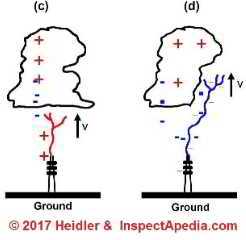 Upward lightning strikes originate at the upper portions of very tall towers, over 100 meters in height. Such tall structures develop an electrical field that exceeds a critical minimum, and that increases further with increases in building height.
Upward lightning strikes originate at the upper portions of very tall towers, over 100 meters in height. Such tall structures develop an electrical field that exceeds a critical minimum, and that increases further with increases in building height.
When the electrical field at the top of a tall tower is strong enough, it can initiate an upwards lightning strike leader that moves towards a storm cloud overhead. Upwards lightning happens mostly during severe winter thunderstorms when the bottom of the storm cloud is closer to the top of the tower.
Upward lightning strikes are very severe, occurring principally at very tall towers like the CN-tower in Canada or the San Chrischona tower in Switzerland.
Image of (c) the initial leader of a negative upward lightning strike between a stormcloud and a tall tower top and (d) the initial leader of a positive upward lightning strike between a stormcloud and a tall tower top is provided by and used courtesy of Heidler et als (2008).
Hold on to your chair while we report that:
- Negative upwards lightning: the initial upwards leader is positive in charge.
- Positive upwards lightning: the initial upwards leader is negative in charge
What the heck? In the two points above I'm paraphrasing lightning experts (Heidler 2008). Below is my interpretation that explains why the charge polarity of the initial upwards leader is not what you might have assumed:
- Negative upwards lightning: My interpretation of their text and illustrations is that a negative upwards lightning strike begins with a positive upwards leader because the leader is attracted to an accumulation of negative charge in the lower portion of the cloud.
- Positive upwards lightning: My further interpretation of the authors' text and illustrations is that a positive upwards lightning strike begins with a negative upward leader because the leader is attracted to a large accumulation of positive charge present in the upper portion of the cloud.
Luckily very-tall tower upward lightning strikes are rare, and it's possible to protect tall towers by sending a rocked-propelled wire into the cloud to discharge the cloud's electrical field before the lightning strike forms to hit the tower.
Return strokes of downwards lightning follow the initial upwards leader. We discussed return strokes as Step 8 - secondary strike formation in our description of downstroke lightning. Multiple return strokes discharge additional current from cloud to ground and may be categorized as
- subsequent short strokes - the first returning strokes of downwards lightning
- long strokes of downwards lightning
9 Steps in Lightning Strike or Bolt Formation
Lightning charge formation in storm clouds, step 1: polarization in the cloud from rising water, negatively-charged cloud bottom
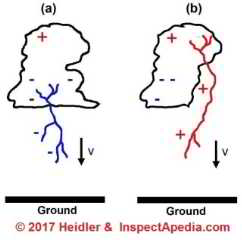 The static electrical charge within a storm cloud becomes polarized: a positive area of static charge forms at the upper area or top of the storm cloud while the lower area of the cloud develops an area of negative static charge. How does this happen?
The static electrical charge within a storm cloud becomes polarized: a positive area of static charge forms at the upper area or top of the storm cloud while the lower area of the cloud develops an area of negative static charge. How does this happen?
Scientists explain this charge polarization by two mechanisms. First is frictional charging that occurs as a result of churning movement of tiny water and ice particles whirling about in the cloud colliding with rising ground moisture.
Image of (a) the initial leader formation of a negative downward lightning strike and (b) the initial leader formation of a positive downward lightning strike formation is provided by and used courtesy of Heidler et als (2008).
[Click to enlarge any image]
Additional moisture rising upwards from the ground as evaporating water forms clusters of droplets that collide with droplets within the cloud. As the ground moisture is rising it naturally will first-impact the lower area of the clouds above.
The collision between these droplets causes separation of and accumulation of (negatively-charged) electrons from droplets (or water molecules or maybe other molecules in the air?) in the bottom area of the cloud.
As water molecules continue to rise, stripped of an electron, they form positive ions that accumulate higher in the cloud while the stripped-electrons accumulate as a negative charge in the lower are of the cloud.
Lightning charge formation in storm clouds, step 2: polarization in the cloud from freezing, more negative charge in the cloud bottom
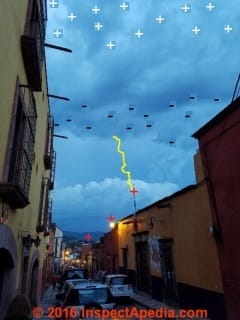 As moisture rising from the ground forms droplets and enters the cloud above, at higher altitudes, especially in colder climates, those droplets begin to freeze.
As moisture rising from the ground forms droplets and enters the cloud above, at higher altitudes, especially in colder climates, those droplets begin to freeze.
Several mechanisms have been offered to explain how freezing contributes to static charge polarization within a storm cloud. Of these, A 2016 Wikipedia article offers a palatable explanation:
During wind-driven collisions, ice crystals tend to develop a positive charge, while a heavier, slushy mixture of ice and water (called graupel) develops a negative charge.
Updrafts within a storm cloud separate the lighter ice crystals from the heavier graupel, causing the top region of the cloud to accumulate a positive space charge while the lower level accumulates a negative space charge. - Wikipedia (2016) cited atReferences or Citations
In sum, the added effect of freezing and movement of lighter, positively-charged ice crystals upwards in the storm cloud, leaving more negatively-charged heavier slush lower in the cloud adds to the polarization of the static electrical charge within the cloud.
Experts note that the frequency of lightning strikes is not uniform over the earth's surface, as climate and weather are important factors. For example, ground strike lightning will be more frequent in colder climates where the contribution of to in-cloud static charge polarization will be greater.
The result of these two stages of electrical charge formation and separation results in an upper-positively-charged area and lower-negatively-charged area in the storm cloud.
Actually our steps 1 and 2 of polarization within the storm cloud are probably occurring more or less at the same time, and at varying rates depending on local conditions such as wind velocity, turbulence, temperature gradients from earth surface to cloud interior, and available moisture on the earth's surface.
Our annotated photo (above) of dark storm clouds low over San Miguel de Allende in Guanajuato, Mexico illustrates how the static charge may move between a high point on the positively-charged earth surface and the negatively-charged lower area of a storm cloud.
Lighting charge formation at the earth's surface, step 3: positive static charge in air & close to earth's surface
According to physics stack exchange,
... thunderstorms maintain a voltage of around +300kV at the electrosphere with respect to the Earth's surface, with a current of around 1 kA slowly discharging around 500 kC of total charge separation. - retrieved 2016/07/25, original source: http://physics.stackexchange.com/questions/3955/what-is-the-net-charge-of-the-earth
The negatively-charged lower area of the storm cloud in turn disturbs the earth's natural electrical field, repelling negative electrons in the space between the cloud's lower area and the earth's surface.
The result of the repelled electrons closer to the earth's surface creates an opposing electrical charge. A positive static charge builds up on the earth's surface including things on that surface that project upwards: trees, mountain tops, people, radio towers, church steeples.
Quibbling Notes on negative vs. positive charges at the earth's surface
While most lightning experts agree that most cloud-to-ground lightning occurs between a negatively-charged cloud bottom and a positive charge on or close-to the earth's surface, at least one lightning expert disagrees, pointing out that the earth's surface is generally charged negatively.
However that author adds that the air is charged positively, being about 100 Vm-1 near the earth's surface. The effects described here in the formation of lightning bolts may increase the positive charge near high points on the earth's surface, thus continuing to support the layman's explanation of groundstroke lighting described here. (Rakov 2003).
A more comprehensible article at english Wikipedia in 2016 helps sort this dilemma:
... there is always some amount of unbound positive and negative, but net positive, electric charge in the atmosphere closest to the surface of the negatively charged Earth on a 'fine day'. When days are not so 'fine', the net unbound charge that exists in the clouds of thunderstorms can be exceedingly negative. - "Atmospheric electricity", Wikipedia 2016.
Lightning strike formation, step 4: plasma formation in air between negative cloud bottom and positively-charged earth's surface
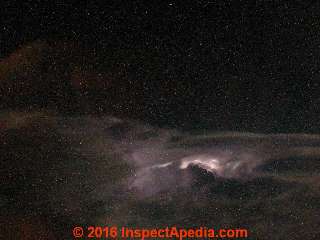 The electrical charge developing in the storm cloud and in the air between the cloud and the earth's surface is strong enough to ionize gas molecules that make up air in the area of the storm. (Ions are particles (really molecules) that have lost electrons (negative ions) or that have gained electrons (positive ions).)
The electrical charge developing in the storm cloud and in the air between the cloud and the earth's surface is strong enough to ionize gas molecules that make up air in the area of the storm. (Ions are particles (really molecules) that have lost electrons (negative ions) or that have gained electrons (positive ions).)
Photo: lightning forming within storm clouds over northern Minnesota, photographed by the author from the air above the storm.
Below a storm cloud, gas molecules in the air have electrons stripped away, becoming positive ions.
Thus the air between the storm cloud and the earth's surface now contains a mixture of both free electrons and positive ions of gases that comprise the air.
Air is abut 78% nitrogen, 21% oxygen, 1% argon and other gases.
This charged air is referred to by physicists as a conductive plasma because the air becomes increasingly capable of conducting an electrical charge.
Lightning strike formation, step 5: formation of the descending step leader
The accumulated electrons in the lower, negatively-charged area of the cloud begin moving through the cloud and the air below downwards towards the earth, following complex pathways probably affected by the presence of other airborne particulates such as dust comprised of earth, pollen, fungal spores, perhaps smoke or other very small particulates. Some areas in the plasma are more conductive than others.
The downwards movement of electrons form a step leader that pushes more electrons in the air down towards the earth's surface. (Remember that two negatively-charged particles tend to repel one another.) This electron push causes the positive charge at the earth's surface below the storm cloud to increase.
The step leader may produce a bright purple glow as it forms a potential pathway between the cloud and the earth's surface.
Lightning strike formation, step 6: formation of the rising streamer
As the descending step leader from the storm cloud pushes electrons downwards and a positive charge accumulates on the earth's surface, the positive charge reaches a level that causes it to begin to move upwards as a rising, positively-charged streamer moving up towards the descending step leader.
When the downward propagating leader approaches ground the electric field at grounded objects increases due to the charge contained in the downward leader channel. As soon as the electric field exceeds a certain level, connecting leaders start from the grounded objects making the final connection between the objects at ground and the downward leader. This is the beginning of the return stroke phase, where the return stroke current flows through the struck object. - Heidler (2008)
Lightning strike formation, step 7: contact between step leader & streamer begin the lightning strike
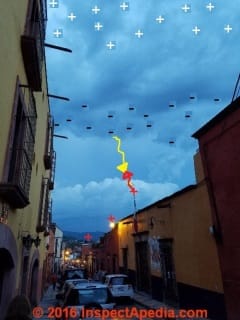 at a height above ground that varies widely but may typically be about 100 meters the upper end of the rising streamer (red arrow in our illustration) contacts the lower end of the step leader (yellow arrow in our photo).
at a height above ground that varies widely but may typically be about 100 meters the upper end of the rising streamer (red arrow in our illustration) contacts the lower end of the step leader (yellow arrow in our photo).
When these two areas of electrical charge make contact the conductive pathway between the storm cloud and the earth's surface has been completed and the lightning strike occurs.
At about 80,000 kilometers per second the area of contact between the top of the positively-charged streamer and the bottom of the negatively-charged step leader zooms upwards towards the storm cloud.
In less than a millisecond (1/1000th of a second), the contact point moves between the point of initial contact (about 100 meters above the ground) to the area of strong negative charge in the bottom of the cloud (height varies).
This is most of what you see when you "see" a lightning strike.
Lightning strike formation, step 8: secondary strike formation
In a typical lightning strike, the rapid rise of the contact point between step leader and streamer - step 7 - is followed (in milliseconds or less) by some secondary electrical surges that follow the same pathway (more or less) between earth and cloud underside.
Lightning strike steps 7 and 8 occur so rapidly and so closely together that to the naked eye these all appear as a single bolt of lightning.
Lightning strike formation, step 9: thunder
The enormous electrical charge (around 100,000 amps) moving through the air during the actual lightning strike described in steps 7 and 8 heats the air around that upwards passage of energy.
That extremely-rapid and very hot (up to 50,000 deg. F - five times hotter than the surface of the sun) heating of air around the strike passage causes the air in that area to expand so rapidly that it creates a shock wave, producing thunder, the tremendous sound that we hear moments after seeing the lightning bolt.
Many of us learn as kids to count second between the time we see the lightning bolt and the time we first hear the thunder produced by that bolt. Divide your seconds count by 4 to get the approximate distance in miles between yourself and where the lightning strike occurred.
...
Continue reading at LIGHTNING PROTECTION, HOW IT WORKS or select a topic from the closely-related articles below, or see the complete ARTICLE INDEX.
Or see these
Recommended Articles
- LIGHTNING BOLT FORMATION & MOVEMENT
- LIGHTNING PROTECTION SYSTEMS - home
- LIGHTNING PROTECTION SYSTEMS, DEFINITIONS
- LIGHTNING PROTECTION, HOW IT WORKS
- LIGHTNING PROTECTION SYSTEM DAMAGED, UNSAFE
- LIGHTNING PROTECTION SYSTEM CERTIFICATION
- LIGHTNING PROTECTION SYSTEM DESIGN
- LIGHTNING PROTECTION for TREES
- LIGHTNING PROTECTION, HIDDEN
- LIGHTNING STRIKE RISK ASSESSMENT
- LIGHTNING, AVOID BEING STRUCK BY
- LIGHTNING STRIKES SMALL BOAT
- SAFETY for ELECTRICAL INSPECTORS
Suggested citation for this web page
LIGHTNING BOLT FORMATION & MOVEMENT at InspectApedia.com - online encyclopedia of building & environmental inspection, testing, diagnosis, repair, & problem prevention advice.
Or see this
INDEX to RELATED ARTICLES: ARTICLE INDEX to LIGHTNING PROTECTION SYSTEMS
Or use the SEARCH BOX found below to Ask a Question or Search InspectApedia
Ask a Question or Search InspectApedia
Try the search box just below, or if you prefer, post a question or comment in the Comments box below and we will respond promptly.
Search the InspectApedia website
Note: appearance of your Comment below may be delayed: if your comment contains an image, photograph, web link, or text that looks to the software as if it might be a web link, your posting will appear after it has been approved by a moderator. Apologies for the delay.
Only one image can be added per comment but you can post as many comments, and therefore images, as you like.
You will not receive a notification when a response to your question has been posted.
Please bookmark this page to make it easy for you to check back for our response.
IF above you see "Comment Form is loading comments..." then COMMENT BOX - countable.ca / bawkbox.com IS NOT WORKING.
In any case you are welcome to send an email directly to us at InspectApedia.com at editor@inspectApedia.com
We'll reply to you directly. Please help us help you by noting, in your email, the URL of the InspectApedia page where you wanted to comment.
Citations & References
In addition to any citations in the article above, a full list is available on request.
- Heidler, F., W. Zischank, Z. Flisowski, Ch Bouquegneau, and C. Mazzetti. PARAMETERS OF LIGHTNING CURRENT GIVEN IN IEC 62305-BACKGROUND, EXPERIENCE AND OUTLOOK [PDF] In 29th International Conference on Lightning Protection, vol. 23, p. 26. 2008.
Abstract:
The paper reviews the various types of lightning ground flashes, the current components relevant for protection and the current parameters obtained from measurements. On the basis of these measurements, some background information is given how TC 81 selected the parameters published in IEC 62305-1. Finally, methods to simulate lightning currents in laboratory are presented which allow the verification of lightning protection measures or components. - Portions of this information are based on UL publication 200-81 11/87 and other local service company information about lightning protection systems and lightning strike hazards.
- Special thanks to Associated Lightning Rod Company, Cooper Road Box 329A, Millerton NY who has been contributing technical content in presentations
to NY ASHI home inspectors since 1996.
Some of that information [on lightning system material and installation details] was edited for clarity. ALRCi can be reached at 518-789-4603, 845-373-8309, 860-364-1498 and will inspect your lightning protection system at no charge.
[InspectApedia.com has no financial nor any other business relationship with any company or product discussed at this website-Ed.] - For more details on how lightning protection systems work,
see LIGHTNING PROTECTION [PDF] rom Pacific Electric and Gas Company,
and ELECTRICAL SYSTEM GROUNDING AND LIGHTNING PROTECTION [PDF] Engineering Technical Letter 90-6, Department of the Air Force, HQ USAF, original source:
http://www.afcesa.af.mil/userdocuments/publications/ETL/ETL 90-6.pdf
This instruction implements Air Force Policy Directive (AFPD) 32-10, Installations and Facilities. It assigns maintenance responsibilities and requirements for electrical grounding systems on Air Force installations, including systems for equipment grounding, lightning protection, and static protection. - Henderson, Tom, "Lightning, static electricity, lesson 4, electric fields", The Physics Classroom, Email: physicsclassroom@comcast.net, retrieved 2016/07/24, original source: http://www.physicsclassroom.com/class/estatics/Lesson-4/Lightning
- Lightning strike risk assessment: for the full body of this excellent article which summarizes recent opinions about lightning
strike risk assessment and safe practices for individuals or groups needing to avoid being struck by lightning,
see Updated Recommendations for Lightning Safety - 1998 Ronald L. Holle and Raul E. Lopez from National Severe Storms Laboratory, NOAA and Norman, Oklahoma, Christoph Zimmermann Global Atmospherics, Inc. Tucson, Arizona - http://www.nssl.noaa.gov/mag/holleetal.html - As we indicated in an original version of this article, a lightning strike risk assessment guide can be found in Appendix I of the National Fire Protection Association's Lightning Protection Code, NFPA #780. The guide considers type of structure, type of construction, structure location, topography, occupancy, contents and lightning frequency. Contact NFPA, Batterymarch Park, Quincy, MA 02269 617-770-3000.
- Lightning Protection Institute, 3365 N. Arlington Heights Rd., Suite J., Arlington Heights IL 60004
- MacGorman, Donald R., Rust MacGorman, W. David Rust, and W. D. Rust. The electrical nature of storms. Oxford University Press on Demand, 1998.
Preface excerpt:
"Our goal has been to produce a modern, graduate level textbook on the electrical processes of storms. The level of our treatment is designed for those with a basic understanding of meteorology or physics and provides the tools needed to explore this cross-disciplinary topic.
Where background material is needed to understand the primary topics of this book, we present basic concepts from the broader context of atmospheric electricity, but these are not treated in as much detail as electrical processes of storms. In each subject area, we include enough references to the scientific literature to make this book useful to professionals, as well as to students." - NOAA SciJinks, WHAT CAUSES LIGHTNING & THUNDER [PDF] NOAA, Jet Propulsion Laboratory 4800 Oak Grove Drive M/S 201-101 Pasadena, CA 91109 USA retrieved 2020/06/30 original source: https://scijinks.gov/lightning/
- NOAA LIGHTNING BASICS [PDF[ NOAA, retrieved 2020/06/30 original source: https://www.nssl.noaa.gov/education/svrwx101/lightning/
Excerpts:
The creation of lightning is a complicated process. We generally know what conditions are needed to produce lightning, but there is still debate about exactly how a cloud builds up electrical charges, and how lightning forms.
Scientists think that the initial process for creating charge regions in thunderstorms involves small hail particles called graupel that are roughly one quarter millimeter to a few millimeters in diameter and are growing by collecting even smaller supercooled liquid droplets.
When these graupel particles collide and bounce off of smaller ice particles, the graupel gains one sign of charge and the smaller ice particle gains the other sign of charge.
Because the smaller ice particles rise faster in updrafts than the graupel particles, the charge on ice particles separates from the charge on graupel particles, and the charge on ice particles collects above the charge on graupel.
Scientists think the two largest charge regions in most storms are caused mainly by graupel carrying negative charge in the middle of the storm and ice particles carrying gained positive charge in the upper part of the storm. However, a small positive charge region often is below the main negative charge region from graupel gaining positive charge at lower, warmer altitudes. - Underwriters Laboratory Standard UL96A. These requirements cover the installation of lightning protection systems on all types of structures other than structures used for the production, handling, or storage of ammunition, explosives, flammable liquids or gases, and other explosive ingredients including dust. These requirements apply to lightning protection systems that are complete and cover all parts of a structure.
Partial systems are not covered by this standard. These requirements do not cover the installation of lightning protection systems for electrical generating, distribution, or transmission systems. These requirements do not cover lightning protection components, which are covered by the Standard for Lightning Protection Components, UL 96. - Underwriters Laboratory Standard UL96: These requirements cover lightning protection components for use in the installation of complete systems of lightning protection on buildings and structures. These requirements do not cover the installation of lightning protection components. Products of this type are covered by the Standard for Installation Requirements for Lightning Protection Systems, UL 96A.
- USDA AVOIDING THE RISKS OF DEADLY LIGHTNING STRIKES [PDF] U.S. Department of Agriculture, retrieved 2020/06/30 original source: https://www.nrcs.usda.gov/wps/portal/nrcs/detail/ks/people/employees/?cid=nrcs142p2_033303
- US EPA, LIGHTNING HAZARD TO FACILITIES HANDLING FLAMMABLE SUBSTANCES [PDF] U.S. EPA, retrieved 2020/06/30 original source: https://www.epa.gov/sites/production/files/2013-11/documents/lit-flam.pdf
- "Lightning Awareness," Gerry Schulte, BMW ON magazine, June 2007 pp. 58-60, provided some technical details about lightning, and refers readers to www.lightningsafety.noaa.gov/outdoors.htm
- "Lightning", retrieved 2016/07/25, original source: https://en.wikipedia.org/wiki/Lightning
- "Atmospheric electricity", retrieved 2016/07/27, original source: https://en.wikipedia.org/wiki/Atmospheric_electricity
Wikipedia provided background information about some topics discussed at this website provided this citation is also found in the same article along with a " retrieved on" date. Because Wikipedia and other website entries can be amended in real time, we cite the retrieval date of such citations and we do not assert that the information found there is always authoritative. - Rakov, Vladimir A., and Martin A. Uman. Lightning: physics and effects. Cambridge University Press, 2003.
Excerpt:
Page 17: "1.4. The global electric circuit . Shortly after the experiment at Marly that confirmed Franklin’s conjecture regarding the electrical nature of thunderstorms (Section 1.1), Lemonnier (1752) discovered atmospheric electrical effects in fair weather. Further research established that the Earth’s surface is charged negatively and the air is charged positively, the associated vertical electric field in fair weather being about 100 V m−1 near the Earth’s surface." (A.Rakov & A. Uman, 2003) - Our recommended books about building & mechanical systems design, inspection, problem diagnosis, and repair, and about indoor environment and IAQ testing, diagnosis, and cleanup are at the InspectAPedia Bookstore. Also see our Book Reviews - InspectAPedia.
- Armor Lightning Protection Inc Manchester Center, VT, 802-375-0266 state-of-the-art lightning protection and surge protection for residential and commercial buildings in Vermont, New England, and throughout the Northeast
- Associated Lightning Rod Company, Inc., Box 329A, Cooper Road, Millerton, NY 12546 914/373-8309 518/789-4603
- A-C Lightning Security, Inc., 2100 East First St., PO Box 329, Maryville MO 64468 816-582-8115 800-821-5575 816-562-2932. In New York, Hudson Valley, contact Christensen Electrical Power Systems, Richard G. Christensen, 518-537-4128.
- Lightning Eliminators & Consultants6687 Arapahoe Road Boulder, CO 80303 (303) 447-2828. "Engineering Solutions For Lightning, Grounding and Surge Protection Worldwide Since 1971"
- Electrical EINET
- Lightning Protection for Facilities, Dr. Bruce Gabrielson, Robert B. Marcus, Published and presented: EMCEXPO92, Washington D.C.
- MIT's Electrical Safety Files
- Lightning Protection for Workers What to Do if You're Outside in a Lightning Storm - Center to Protect Workers' Rights (PDF)
- 1998 and Current Lightning Protection Conferences & Exhibitions
- Lightning Risk and Hazard Analysis Measurement from the National Lightning Safety Institute (NLSI).
- "Lightning Fatalities, Injuries, and Damage Reports in the United States from 1959-1994", E. Brian Curran, Ronald L. Holle, Raul E. Lopez, NOAA Technical Memorandum NWS SR-193 October 1997
- UL - Underwriters Labs Lightning equipment certification program. "Underwriters Laboratories Inc. (UL) has been testing and certifying lightning protection equipment since 1908. UL issues certificates of conformance for systems, inspecting system components and checking completed installations. Installations are required to comply with UL's internationally recognized Standards for lightning protection systems. Manufacturers, suppliers and installers demonstrate their commitment to safety by building, selling and installing only those lightning protection products that pass UL's rigorous testing." -- (Op.Cit.)
- In addition to citations & references found in this article, see the research citations given at the end of the related articles found at our suggested
CONTINUE READING or RECOMMENDED ARTICLES.
- Carson, Dunlop & Associates Ltd., 120 Carlton Street Suite 407, Toronto ON M5A 4K2. Tel: (416) 964-9415 1-800-268-7070 Email: info@carsondunlop.com. Alan Carson is a past president of ASHI, the American Society of Home Inspectors.
Thanks to Alan Carson and Bob Dunlop, for permission for InspectAPedia to use text excerpts from The HOME REFERENCE BOOK - the Encyclopedia of Homes and to use illustrations from The ILLUSTRATED HOME .
Carson Dunlop Associates provides extensive home inspection education and report writing material. In gratitude we provide links to tsome Carson Dunlop Associates products and services.

